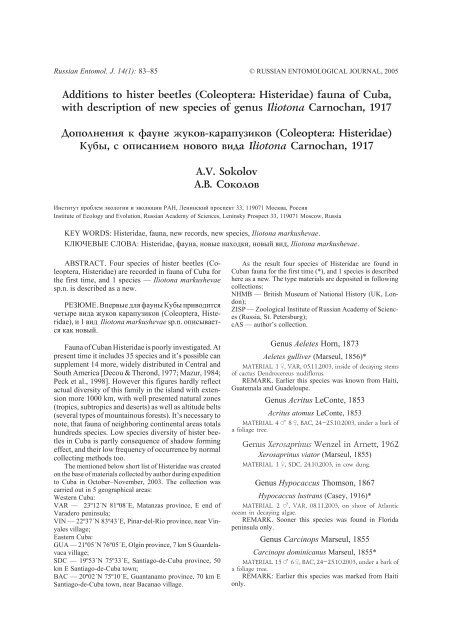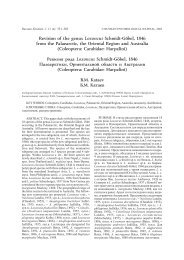Full PDF Version
Full PDF Version
Full PDF Version
Create successful ePaper yourself
Turn your PDF publications into a flip-book with our unique Google optimized e-Paper software.
Russian Entomol. J. 14(1): 83–85<br />
© RUSSIAN ENTOMOLOGICAL JOURNAL, 2005<br />
Additions to hister beetles (Coleoptera: Histeridae) fauna of Cuba,<br />
with description of new species of genus Iliotona Carnochan, 1917<br />
Äîïîëíåíèÿ ê ôàóíå æóêîâ-êàðàïóçèêîâ (Coleoptera: Histeridae)<br />
Êóáû, ñ îïèñàíèåì íîâîãî âèäà Iliotona Carnochan, 1917<br />
A.V. Sokolov<br />
À.Â. Ñîêîëîâ<br />
Èíñòèòóò ïðîáëåì ýêîëîãèè è ýâîëþöèè ÐÀÍ, Ëåíèíñêèé ïðîñïåêò 33, 119071 Ìîñêâà, Ðîññèÿ<br />
Institute of Ecology and Evolution, Russian Academy of Sciences, Leninsky Prospect 33, 119071 Moscow, Russia<br />
KEY WORDS: Histeridae, fauna, new records, new species, Iliotona markushevae.<br />
ÊËÞ×ÅÂÛÅ ÑËÎÂÀ: Histeridae, ôàóíà, íîâûå íàõîäêè, íîâûé âèä, Iliotona markushevae.<br />
ABSTRACT. Four species of hister beetles (Coleoptera,<br />
Histeridae) are recorded in fauna of Cuba for<br />
the first time, and 1 species — Iliotona markushevae<br />
sp.n. is described as a new.<br />
ÐÅÇÞÌÅ. Âïåðâûå äëÿ ôàóíû Êóáû ïðèâîäèòñÿ<br />
÷åòûðå âèäà æóêîâ êàðàïóçèêîâ (Coleoptera, Histeridae),<br />
è 1 âèä Iliotona markushevae sp.n. îïèñûâàåòñÿ<br />
êàê íîâûé.<br />
Fauna of Cuban Histeridae is poorly investigated. At<br />
present time it includes 35 species and it’s possible can<br />
supplement 14 more, widely distributed in Central and<br />
South America [Decou & Therond, 1977; Mazur, 1984;<br />
Peck et al., 1998]. However this figures hardly reflect<br />
actual diversity of this family in the island with extension<br />
more 1000 km, with well presented natural zones<br />
(tropics, subtropics and deserts) as well as altitude belts<br />
(several types of mountainous forests). It’s necessary to<br />
note, that fauna of neighboring continental areas totals<br />
hundreds species. Low species diversity of hister beetles<br />
in Cuba is partly consequence of shadow forming<br />
effect, and their low frequency of occurrence by normal<br />
collecting methods too.<br />
The mentioned below short list of Histeridae was created<br />
on the base of materials collected by author during expedition<br />
to Cuba in October–November, 2003. The collection was<br />
carried out in 5 geographical areas:<br />
Western Cuba:<br />
VAR — 23º12´N 81º08´E, Matanzas province, E end of<br />
Varadero peninsula;<br />
VIN — 22º37´N 83º43´E, Pinar-del-Rio province, near Vinyales<br />
village;<br />
Eastern Cuba:<br />
GUA — 21º05´N 76º05´E, Olgin province, 7 km S Guardelavaca<br />
village;<br />
SDC — 19º53´N 75º33´E, Santiago-de-Cuba province, 50<br />
km E Santiago-de-Cuba town;<br />
BAC — 20º02´N 75º10´E, Guantanamo province, 70 km E<br />
Santiago-de-Cuba town, near Bacanao village.<br />
As the result four species of Histeridae are found in<br />
Cuban fauna for the first time (*), and 1 species is described<br />
here as a new. The type materials are deposited in following<br />
collections:<br />
NHMB — British Museum of National History (UK, London);<br />
ZISP — Zoological Institute of Russian Academy of Sciences<br />
(Russia, St. Petersburg);<br />
cAS — author’s collection.<br />
Genus Aeletes Horn, 1873<br />
Aeletes gulliver (Marseul, 1856)*<br />
MATERIAL. 1 $, VAR, 05.11.2003, inside of decaying stems<br />
of cactus Dendrocereus nudiflorus.<br />
REMARK. Earlier this species was known from Haiti,<br />
Guatemala and Guadeloupe.<br />
Genus Acritus LeConte, 1853<br />
Acritus atomus LeConte, 1853<br />
MATERIAL. 4 # 8 $, BAC, 24–25.10.2003, under a bark of<br />
a foliage tree.<br />
Genus Xerosaprinus Wenzel in Arnett, 1962<br />
Xerosaprinus viator (Marseul, 1855)<br />
MATERIAL. 1 $, SDC, 24.10.2003, in cow dung.<br />
Genus Hypocaccus Thomson, 1867<br />
Hypocaccus lustrans (Casey, 1916)*<br />
MATERIAL. 2 #, VAR, 08.11.2003, on shore of Atlantic<br />
ocean in decaying algae.<br />
REMARK. Sooner this species was found in Florida<br />
peninsula only.<br />
Genus Carcinops Marseul, 1855<br />
Carcinops dominicanus Marseul, 1855*<br />
MATERIAL. 15 # 6 $, BAC, 24–25.10.2003, under a bark of<br />
a foliage tree.<br />
REMARK: Earlier this species was marked from Haiti<br />
only.
84 A. V. Sokolov<br />
1<br />
4 5<br />
Figs 1–5. Iliotona markushevae sp.n.: 1 — habitus, dorsal view; 2 — labrum, anterior view; 3 — submentum, ventral view; 4 —<br />
aedeagus, ventral view; 5 — the same, lateral view.<br />
Ðèñ. 1–5. Iliotona markushevae sp.n.: 1 — ãàáèòóñ, ñâåðõó; 2 — âåðõíÿÿ ãóáà, ñïåðåäè; 3 — ïîäáîðîäîê, ñíèçó; 4 — ýäåàãóñ,<br />
ñíèçó; 5 — òî æå, ñáîêó.<br />
2<br />
3
Additions to hister beetles fauna of Cuba, with description of new species of genus Iliotona<br />
Carcinops sp.<br />
MATERIAL. 18 # 14 $, VAR, 05–08.11.2003, inside of<br />
decaying stems of cactus D. nudiflorus (VAR).<br />
REMARK: This species more closed to C. cribripuga<br />
Wenzel but differs by metallic-green color of body and<br />
abbreviated 5 th and 6 th dorsal striae.<br />
Genus Epierus Erichson, 1834<br />
Epierus antillarum Marseul, 1854<br />
MATERIAL. 13 # 8 $, BAC, 24–25.10.2003, under a bark of<br />
a foliage tree.<br />
Genus Hister Linnaeus, 1758<br />
Hister coenosus Erichson, 1834<br />
MATERIAL. 5 # 2 $, GUA, 20.10.2003, in cow dung.<br />
Genus Omalodes Erichson, 1834<br />
Omalodes ruficlavis Marseul, 1853<br />
MATERIAL. 3 # 2 $, VAR, 05–08.11.2003, inside of<br />
decaying stems of cactus D. nudiflorus.<br />
Genus Phelister Marseul, 1853<br />
Phelister haemorrhous Marseul, 1853<br />
MATERIAL. 3 # 7 $, GUA, 20.10.2003, in cow dung; 3 #,<br />
BAC, 24–25.10.2003, in cow dung; 1#, VAR, 07.11.2003, in<br />
human excrements; 2 # 1 $, VIN, 29–30.10.2003, in cow dung.<br />
Phelister omissus Schmidt, 1893*<br />
MATERIAL. 2 # 1 $, VIN, 20.10.2003, in cow dung; 2 #,<br />
29–GUA, 30.10.2003, in cow dung.<br />
REMARK: Sooner this species was known only from<br />
Paraguay, Argentina and Costa-Rica. It’s probably widespread<br />
in Central and South America.<br />
Genus Iliotona Carnochan, 1917<br />
Iliotona markushevae Sokolov sp.n.<br />
MATERIAL. Holotype, #, W Cuba, Matanzas province, E<br />
end of Varadero peninsula, 05.11.2003, inside of decaying stems<br />
of cactus Dendrocereus nudiflorus, A. Sokolov. Paratypes, 2##<br />
and 1 $, collected together with holotype. Holotype and one of<br />
paratype ($) are deposited in cAS, 1 paratype — in collection of<br />
NHMB, 1 paratype — in collection of ZISP.<br />
ADDITIONAL MATERIAL. 4 $$ (syntypes) of I. dorcoides<br />
Lewis, Mexico (NHMB); 3 specimens of I. cacti LeConte: 1#1$,<br />
California, San Diego, 1 $, California, Îrange count, Laguna<br />
Beach (ZISP).<br />
DESCRIPTION. Habitus as in Fig. 1. Body length, male<br />
8.9–10.9 mm (full length up to 22.2 mm), female 8.1 mm.<br />
Oblong-oval, moderately convex, black, shining. Legs black,<br />
club of antennae grey. Head very massive. Frons slightly<br />
more convex than in I. dorcoides, clothed by very fine and<br />
sparse punctures, with two deep striae. Superorbital striae<br />
well developed, reaching the anterior edge of eyes, clypeus<br />
concave. Labrum as in Fig. 2. Mandibles elongate, 1.5–1.7<br />
times (mean 1.55) longer than head, straights, feebly curved<br />
at apex; it’s basal part dilated, narrows fluently to the middle,<br />
with distinct tooth medially. Submentum not concave, with<br />
slightly shagreened surface (Fig. 3).<br />
Pronotum sixangular (Fig. 1), with strongly projected<br />
lateral sides, creating obtuse angles (in one specimen right<br />
angular projection rounded), anterior angles feebly arcuate<br />
inward. Marginal striae rather wide and deep, complete laterally,<br />
reaching to anterior margin and interrupted behind eyes<br />
level. Pronotal disk extremely sparsely and finely punctured,<br />
85<br />
with 2 pairs of round shallow depressions, one of which<br />
situated closer to lateral side slightly above angular projection<br />
while the other placed more closer to center of disk and<br />
apically. Male with deep oblong groove prolonged from<br />
angular projection to anterior pronotal angle.<br />
Elytra smooth, with strongly convex humeral area, narrow<br />
to apex, 1 st and 2 nd dorsal striae present by basal rudiments,<br />
sometimes with short fragment of 2 nd dorsal stria near<br />
the middle of disk. Subhumeral stria long, moving from apex<br />
to shoulders. Outer angles of apical elytral part punctured and<br />
rugous. Visible parts of 5 th tergite dull, sparsely and irregularly<br />
punctured. Sides of propygidium dull, with rather coarse<br />
and sparse (2–4) punctures. Apical punctures finer and slightly<br />
sparser. Propygidium disk looks as smooth but in fact with<br />
very fine and sparse punctures. Pygidium dull, similarly but<br />
more densely punctured than propygidium sides (1–1.5).<br />
Sides of meso- and metasternum rugous, the middle<br />
smooth. Lateral metasternal suture obsolete, rarely present by<br />
short fragment. Femurs thinner and longer in comparison<br />
with other Iliotona species.<br />
Aedeagus as in Figs 4–5.<br />
ETYMOLOGY. A new species is named in honour of my<br />
wife K.V. Markusheva, who very helped in collecting material<br />
for this article.<br />
BIOLOGY. All exemplars of new species were collected<br />
near seashore in thorn forest on karst limestones, similar with<br />
Brasilian caatinga. The beetles were founded only inside<br />
decaying stems of endemic cactus Dendrocereus nudiflorus,<br />
habitually like as thick-trunk tree. Breaking and decaying<br />
stems are unique humid microbiotope in such dry locality,<br />
with which many groups of arthropods are connected.<br />
COMPARATIVE REMARKS. At present time genus<br />
Iliotona included two species only, which are distributed in<br />
Mexico and California. From both I. markushevae sp.n.<br />
easily distinguished by form of pronotum, developed frontal<br />
striae, reduced dorsal striae, convex shoulders, as well as<br />
longer femurs.<br />
KEY FOR IDENTIFICATION OF ILIOTONA SPECIES<br />
1 Pygidium unmargined. Mandibles with teeth in the middle<br />
part .......................................................................... 2<br />
— Pygidium margined. Mandibles without teeth in the middle<br />
part ............................................... I. cacti (LeConte)<br />
2 Lateral side of pronotum without angular projection, with<br />
deep transversal groove in apical one third; first dorsal<br />
stria not abbreviate .......................... I. dorcoides Lewis.<br />
— Lateral side of pronotum with angular projection, without<br />
deep transversal groove; first dorsal stria present by<br />
rudiment ........................................ I. markushevae sp.n.<br />
ACKNOWLEGMENTS. Author is very grateful to Dr.<br />
Martin Brendell (BMNH) and Dr. Boris A. Korotyaev (ZISP)<br />
for given material on investigations, as well as to Dr. Max<br />
Barklay (BMNH) for help in reception of a material to<br />
Russia, and Dr. A.V. Matalin for valuable remarks on structure<br />
of manuscript.<br />
References<br />
Decou V. & Therond J. 1977. Histerides hypoges de Cuba //<br />
Results des expeditions biospeciologiques Cubano-romaines<br />
a Cuba. Editura Academiei Republicii Socialiste Romania.<br />
Bucarest. Vol.2. P.403–405.<br />
Peck S., Ruiz-Baliu A. & Garces Gonzales G. 1998. The Caveinhabiting<br />
Beetles of Cuba (Insecta: Coleoptera): Diversity,<br />
Distribution and Ecology // Journal of Cave and Karst<br />
Studies. Vol.60. ¹3. P.156–166.<br />
Mazur S. 1984. A world catalogique of Histeridae // Polskie<br />
pismo entmologiczne. Vol.54. F.3–4. P.1–376.












